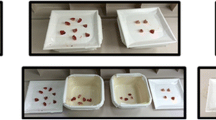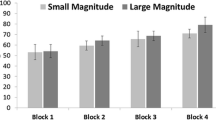Abstract
In everyday life, humans and animals occupying different rungs of the “evolutionary ladder” often have to evaluate the notions of larger/smaller size (predator/prey, rival/ally, etc.) and flat/volumetric shape (fruit/leaf, 2D/3D images, etc.). The aim of this study was to find out experimentally which of the following two tasks related to the formation of the preverbal notions of larger/smaller size or flat/volumetric shape is easier to train rhesus monkeys. The first task was to form or actualize the notion of larger or smaller size upon co-presentation of 4 flat or volumetric figures. The second task was to form or actualize the notion of flat or volumetric object among 4 figures of the same size (small, medium or large) presented simultaneously. To be rewarded during the formation of both notions, the animal was supposed to choose a figure which was different from the other three in the trial. In both tasks, the number of trials required to reach or exceed the 70% level of correct task implementation per each type of training was counted. This allowed optimization of the notion formation algorithm to rule out strong skill consolidation (overtraining) that might inhibit the formation of a new skill in further training. When the number of trials was averaged over all types of training, the notion of shape formed faster than the notion of size. This discrepancy was only observed under the difficulty of solving one of the task types–discriminating between objects poorly distinguishable (1.5 times) by their size. However, in the situation of no difficulty in discriminating between figures during their perception (more than a 2-fold difference in size), the number of trials in forming the notions of size and shape was statistically indistinguishable. Since training rates in forming the notions of larger/smaller size or flat/volumetric shape were indistinguishable in simple choice situations, we suggest that these notions are equally important for rhesus monkeys.
Similar content being viewed by others
References
Zorina, Z.A. and Smirnova, A.A., O chem rasskazali “govoryashchie” obez’yany (What “Talking” Monkeys Talked About), Moscow, 2006.
Tikhomirov, O.K., Lektsii po psikhologii (Lectures on Psychology), Moscow, 2008.
Firsov, L.A. and Chizhenkov, A.M., Evolyutsiya intellekta (prisushch li razum zhivotnym) [Evolution of Intelligence (Is Mind Inherent to Animals?)], St. Petersburg, 2004.
Kant, I., Kritika chistogo razuma (Critique of Pure Reason), Moscow, 1994.
Gardner, R.A. and Gardner, B.T., Teaching sign language to a chimpanzee, Science, 1969, vol. 165, pp. 664–672.
Gillan, D.J., Premack, D., and Woodruff, G., Reasoning in chimpanzee: I. Analogical reasoning, J. Exp. Psychol. Anim. Behav. Proc., 1981, vol. 7, pp. 1–17.
Lyn, H., Mental representation of symbols as revealed by vocabulary errors in two bonobos (Pan paniscus), Anim. Cogn., 2007, vol. 10, pp. 461–475.
Miles, H.L., The cognitive foundations for reference in a signing orangutan, Language and Intelligence in Monkeys and Apes: Comparative Developmental Perspectives, Parker, S.T. and Gibson, K.R., Eds., Cambridge, 1990, pp. 511–539.
Patterson, F.G., The gestures of a gorilla: language acquisition in another pongid, Brain Lang., 1978, vol. 5, pp. 72–97.
Savage-Rumbaugh, E.S., Communication, symbolic communication, and language: reply to Seidenberg and Pettito, J. Exp. Psychol. Gen., 1987, vol. 116, pp. 288–292.
Malyukova, I.V., Nikitin, V.S., Uvarova, I.A., and Silakov, V.L., Comparative physiological investigation of the function of generalization in primates, Zh. Evol. Biokhim. Fiziol., 1990, vol. 26, no. 6, pp. 801–810.
Malyukova, I.V. and Molotova, N.G., Cognitive behavior of chimpanzee at adolescence, Zh. Vyssh. Nervn. Deyat., 1995, vol. 45, no. 2, pp. 410–412.
Fagot, J. and Maugard, A., Analogical reasoning in baboons (Papio papio): flexible reencoding of the source relation depending on the target relation, Learn. Behav., 2013, vol. 41, pp. 229–237.
Fagot, J., Wasserman, E.A., and Young, M.E., Discriminating the relation between relations: The role of entropy in abstract conceptualization by baboons (Papio papio) and humans (Homo sapiens), J. Exp. Psychol. Anim. Behav. Proc., 2001, vol. 27, pp. 316–328.
Truppa, V., Mortari, E.P., Garofoli, D., Privitera, S., and Visalberghi, E., Same/different concept learning by capuchin monkeys in matchingto-sample task, PLoS ONE, 2011, vol. 6(8):e23809.
Wasserman, E.A., Young, M.E., and Jagot, J., Effects of number of items on the baboon’s discrimination of same from different visual displays, Anim. Cogn., 2001, vol. 4, pp. 163–170.
Firsov, L.A., Pamyat’ u primatov (Memory in Primates), Leningrad, 1972.
Malyukova, I.V. and Chernikova, N.A., Complex behavioral forms in the lower monkeys in the process of identification of quantitative signs of visual stimuli, Zh. Evol. Biokhim. Fiziol., 2008, vol. 44, no. 4, pp. 429–434.
Call, J., Estimating and operating on discrete quantities in orangutans (Pongo pigmaeus), J. Comp. Psychol., 2000, vol. 114, pp. 136–147.
Matsuzawa, T., Use of numbers by a chimpanzee, Nature, 1985, vol. 13, pp. 57–59.
Rumbaugh, D.M. and Washburn, D.A., Intelligence of Apes and Other Rational Beings, New Haven and London, 2003.
Woodruff, G. and Premack, D., Primitive mathematical concepts in the chimpanzee: proportionality and numerosity, Nature, 1981, vol. 293, pp. 568–570.
Nikitin, V.S. and Firsov, L.A., Organization of complex forms of mnestic activity in monkeys, Mekhanizmy adaptivnogo povedeniya (Mechanisms of Adaptive Behavior), Leningrad, 1986.
Author information
Authors and Affiliations
Corresponding author
Additional information
Original Russian Text © D.L. Tikhonravov, N.M. Dubrovskaya, I.A. Zhuravin, 2018, published in Zhurnal Evolyutsionnoi Biokhimii i Fiziologii, 2018, Vol. 54, No. 3, pp. 205–211.
Rights and permissions
About this article
Cite this article
Tikhonravov, D.L., Dubrovskaya, N.M. & Zhuravin, I.A. The Notions of Size and Shape in Old World Monkeys (Macaca mullata): A Comparative Analysis of the Formation Process. J Evol Biochem Phys 54, 234–241 (2018). https://doi.org/10.1134/S0022093018030080
Received:
Published:
Issue Date:
DOI: https://doi.org/10.1134/S0022093018030080




